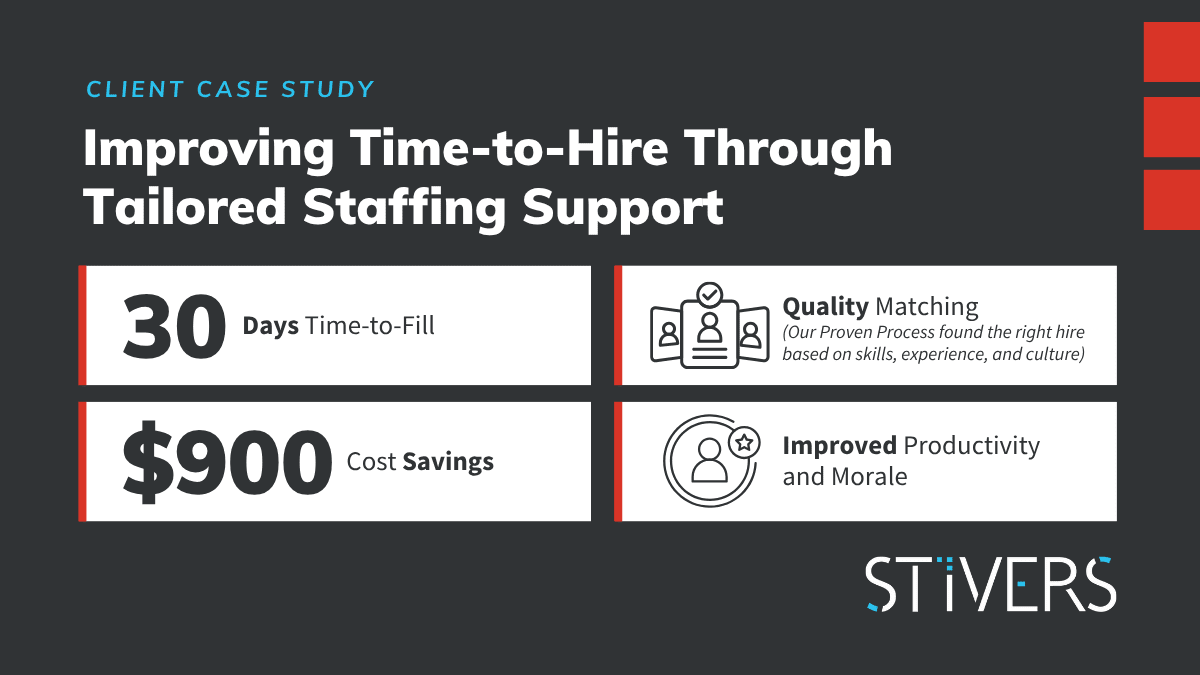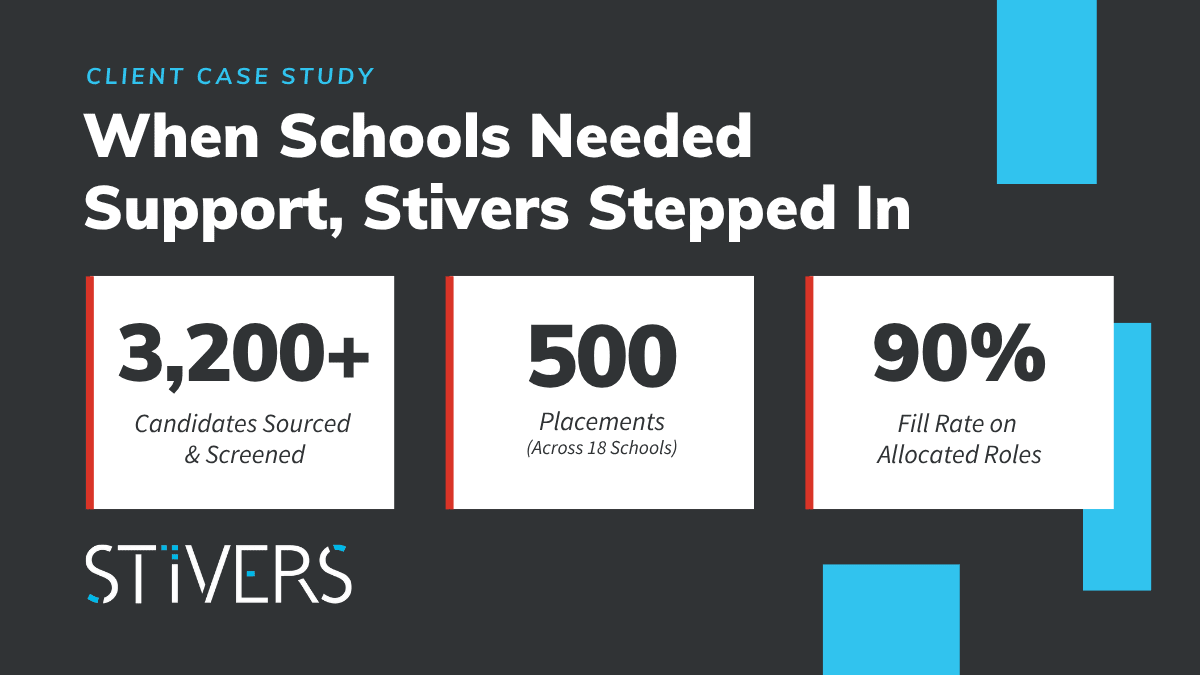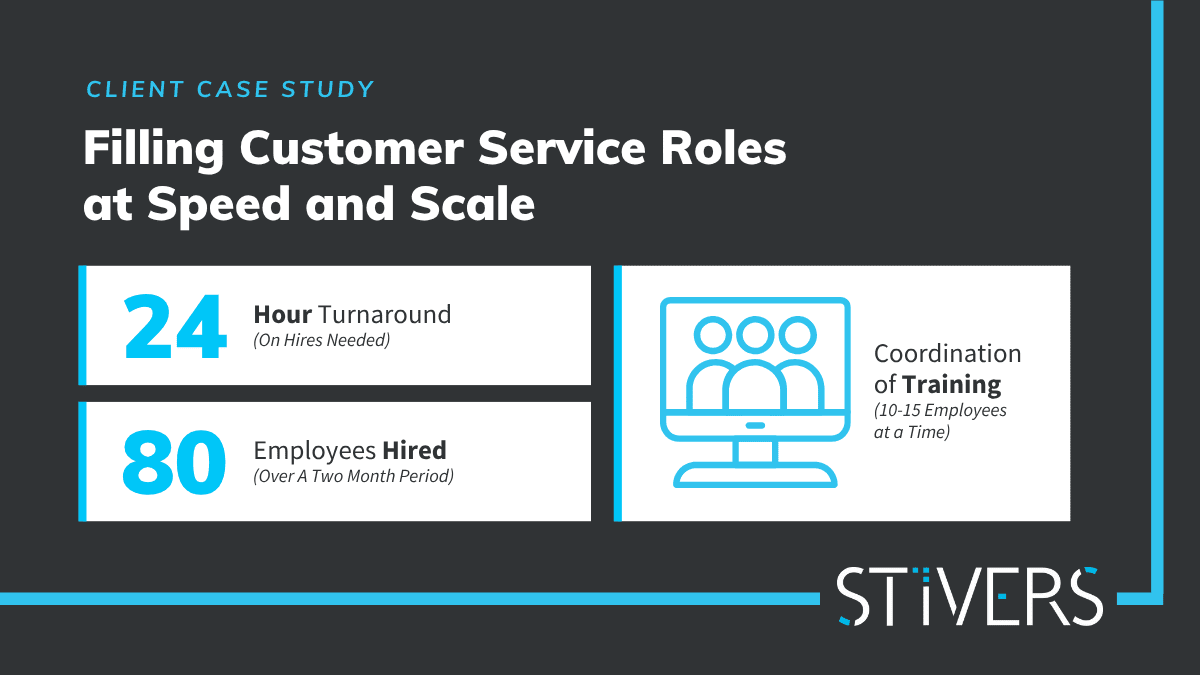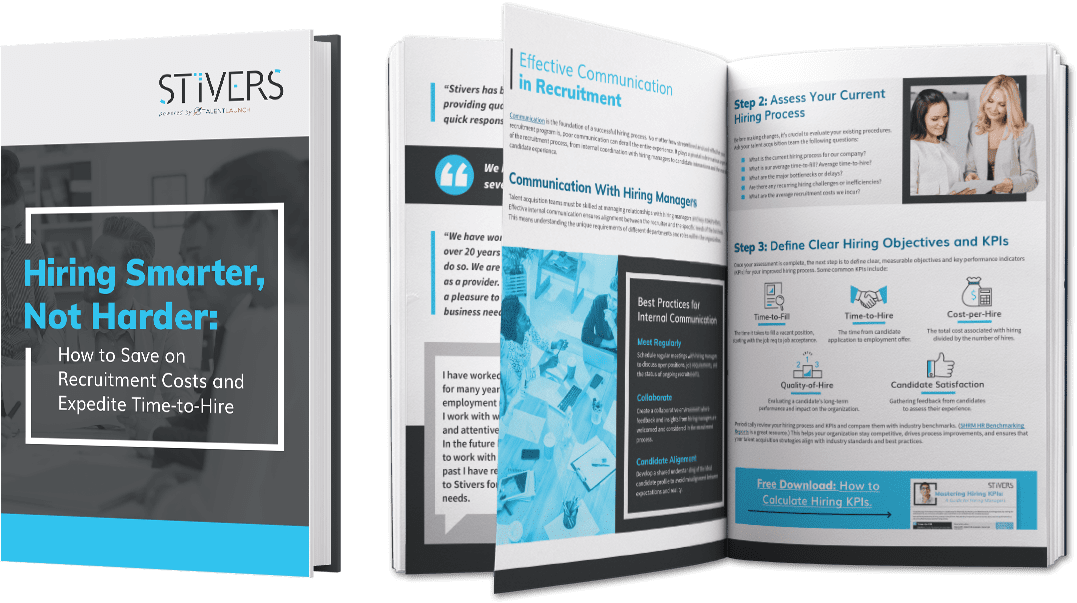Losing valuable employees is a costly problem for businesses of all sizes and in all industries. But what if you could prevent turnover by focusing on what makes your employees want to stay?
The good news? You absolutely can. And it starts with engagement.
When employees feel heard, valued, and excited about their future, they’re not just showing up for a paycheck—they’re invested in their work and your company’s success.
Stay interviews and career pathing work together as a powerful engagement and retention tool, giving employees a voice and a vision for their future. When done right, these two strategies create an ongoing conversation that not only keeps employees engaged but also makes your workplace one they don’t want to leave.
3 Words To Help Build The Best Employee Retention Strategy
read the blog
Stay Interviews: More Than Just a Check-In
At their core, stay interviews are about connection. Unlike exit interviews, which tell you why someone is leaving after it’s too late, stay interviews uncover what motivates employees to stay while you still have time to act on it.
Think of them as an engagement pulse check.
What’s working well?
What could be better?
What would make their job more fulfilling?
These conversations provide insight into what employees need to stay engaged and productive. And the feedback you collect? It’s a goldmine for building meaningful career paths that align with their goals.
Stay Interview Purpose and Best Practices
- Purpose: Stay interviews help identify engagement risks, improve workplace culture, and strengthen employee retention strategies.
- Best Practices: Conduct stay interviews regularly, create a safe space for open feedback, and follow up with meaningful action.
- Format: Stay interviews can be structured as one-on-one conversations using a stay interview toolkit with a consistent format.
A Paychex survey found that 27% of HR decision-makers in the U.S. utilize stay interviews as part of their retention strategies.
Career Pathing: Turning Engagement Into Long-Term Commitment
Stay interviews help you understand what employees need, but career pathing is what fuels their motivation.
Employees want to see where they’re headed, and career pathing gives them a clear, achievable progression within the company.
Career development programs in companies that prioritize structured career pathing help employees feel a sense of purpose and direction. If they feel stuck, unchallenged, or uncertain about their future, disengagement creeps in.
Career pathing helps by:
- Providing clarity on growth opportunities
- Offering skill development and training
- Creating small, achievable milestones that keep employees engaged
- Supporting career progression through mentorship and leadership programs
When employees can connect the dots between their current role and their future potential, they’re more likely to stay invested in both their work and your company. In fact, research indicates that 94% of employees would stay longer at a company if it invested in their career development.
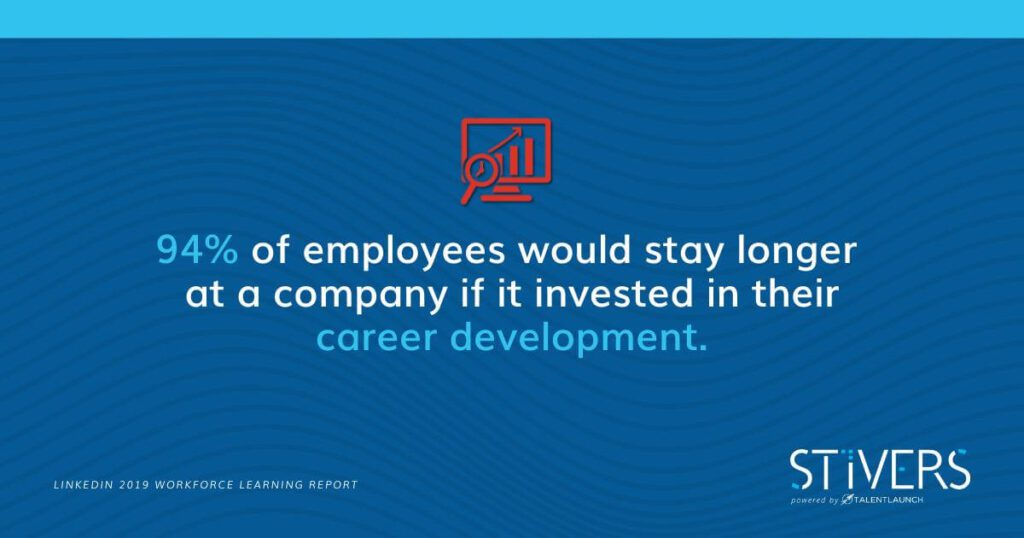
Example Career Path: Human Resources Professional
Let’s illustrate career pathing with a hypothetical example.
Meet Sam, who’s starting their HR career in an entry-level position.
Their potential progression highlights how this process provides a clear roadmap for advancement, emphasizing the importance of skill development, training, certifications, and mentorship at each stage.
Current Role: HR Assistant
In this entry-level role, Sam focuses on building foundational HR knowledge and developing organizational skills through administrative tasks like onboarding, managing HR paperwork, and answering employee inquiries.
Next Step: HR Generalist
After demonstrating proficiency as an HR Assistant, Sam might move into an HR Generalist role. They now apply HR knowledge in diverse situations, developing problem-solving skills across employee relations, benefits, recruitment, and compliance.
Certifications like SHRM-CP or PHR become valuable.
Mid-Career: HR Business Partner or HR Manager
Sam provides strategic HR guidance as an HR Business Partner, working directly with departments.
Alternatively, as an HR Manager, they oversee HR functions like talent acquisition or compensation and benefits, leading a team of HR professionals.
Leadership development and mentorship are crucial at this stage, and certifications like SHRM-SCP or SPHR are pursued.
Senior Level: HR Director or VP of HR
At the senior level, Sam might become an HR Director, overseeing all HR functions. Or they develop and implement overall HR strategy as a VP of HR, advising senior leadership.
Executive coaching and industry conference participation become valuable for continued growth.
Executive Level: Chief Human Resources Officer (CHRO)
The pinnacle of Sam’s HR career path is often the CHRO role, where they serve as a key member of the executive team and are responsible for aligning HR strategy with overall business objectives and driving organizational change.
Deep business acumen, strategic thinking, and exceptional leadership skills are essential at this level.
By offering personalized career paths like Sam’s, your company can keep its HR professionals engaged and motivated, reducing turnover and building a strong HR team.
Transforming HR Recruitment:
read the blog
How Stivers Filled a Critical Role in Just 10 Days
Stay Interviews and Career Pathing: The Perfect Engagement Loop
Here’s where the magic happens: Stay interviews uncover what employees need, and career pathing delivers on those needs.
If an employee shares that they feel stagnant, career pathing offers a roadmap for growth.
If they’re eager to develop new skills, career pathing creates opportunities to learn and advance.
Employees who see their feedback turn into real career opportunities become more engaged, more productive, and less likely to look elsewhere.
And when employees are engaged, retention takes care of itself. Organizations implementing stay interviews have reported significant improvements in retention, with some experiencing up to a 70% reduction in turnover within the first six months.
How to Use These Strategies to Keep Employees Engaged
Now that you’ve seen how career pathing can work in practice, let’s explore how to implement these strategies in your own organization. Starting with stay interviews, like the ones that would help Sam define their goals.
Stay interviews and career pathing aren’t just one-and-done tasks—they should be an ongoing part of your company culture.
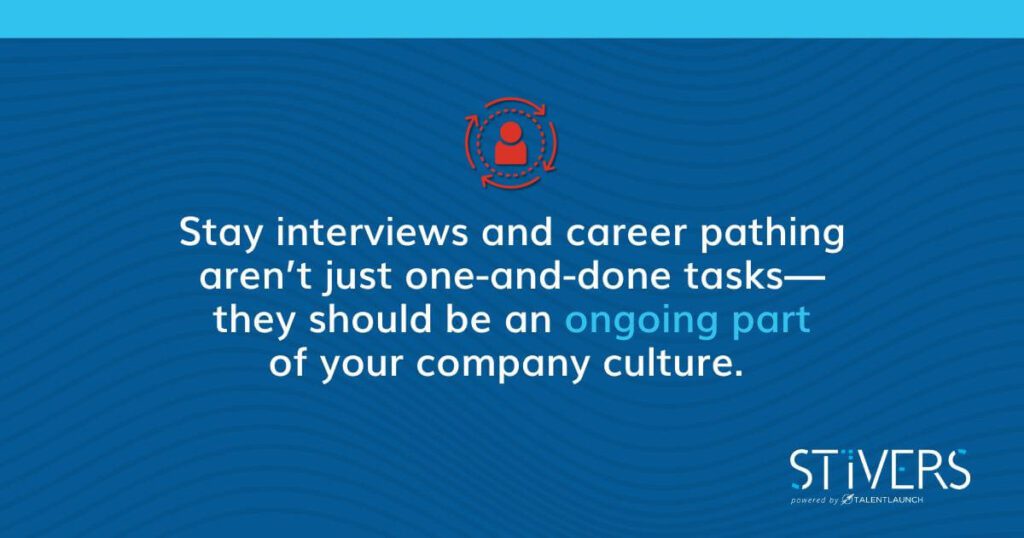
Implementing these strategies effectively requires a consistent and structured approach. Here’s how to make them work together.
Ask engagement-focused stay interview questions:
- “What excites you most about your work?“
- “Are there skills you’d like to develop to feel more fulfilled in your role?“
- “What would make your job more engaging on a daily basis?“
- “Where do you see yourself in your career path within the company?“
- “What support do you need to achieve your career progression goals?“
Follow up with engagement-driven career pathing:
- Provide clear, personalized growth plans so employees feel their work has direction.
- Offer mentorship and training to keep employees engaged and excited about new challenges.
- Schedule regular career check-ins to monitor progress and provide feedback.
- Use retention interviews to measure the effectiveness of career development programs.
Engagement First, Retention Follows
Stay interviews and career pathing aren’t just about keeping employees from leaving—they’re about giving them a reason to stay. When employees are engaged in their growth, they invest back into their work and your company.
Sam’s career path is just one example. Imagine the possibilities when you extend this approach to every member of your team. This same principle applies across all departments and levels within your organization.
If you’re looking for a low-cost, high-impact way to boost retention, start by focusing on engagement. Listen to what your employees need, show them a path forward, and watch how career pathing keeps them invested for the long haul.
Investing in engagement is not just good for your employees; it’s good for your bottom line.
Maximize Your Talent Retention Efforts
Explore the Stivers blog for expert insights and join our staffing hub for exclusive resources and updates delivered right to your inbox.
